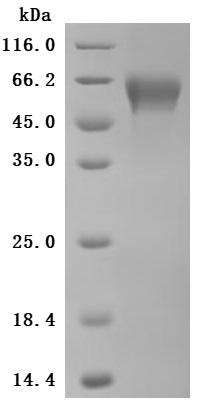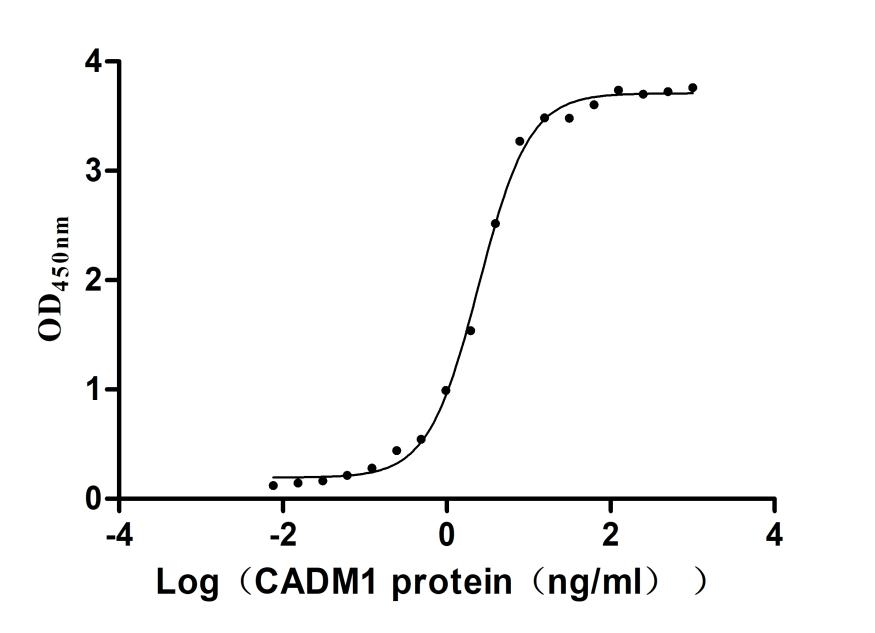The recombinant human CRTAM protein (amino acids 18-287) is expressed in mammalian cells with a C-terminal 10×His tag, ensuring proper folding and post-translational modifications. This protein demonstrates high purity (>95% by SDS-PAGE) and low endotoxin levels (<1.0 EU/μg, LAL method), meeting stringent quality standards. Functional validation via ELISA confirms its specific interaction with human CADM1 (CSB-MP004425HUd9) (EC50: 2.277–2.649 ng/mL at 2 μg/mL immobilization), highlighting its role in T-cell-mediated immune responses. The mammalian expression system preserves native structural features critical for studying CRTAM's involvement in cell adhesion, immune regulation, and cytotoxic activity. Provided as lyophilized powder, this recombinant CRTAM protein ensures stability and easy reconstitution, making it ideal for investigating CRTAM-CADM1 signaling in autoimmune diseases, cancer immunology, and lymphocyte activation studies. The His tag facilitates purification without compromising functional epitopes.
Human CRTAM is a type I transmembrane protein that plays a significant role in the immune system, particularly concerning T cell and natural killer (NK) cell activation and function. CRTAM is primarily expressed on activated CD8+ T cells and invariant natural killer T (iNKT) cells, where it mediates cell adhesion and cytotoxic responses. Its expression is notably higher in activated states, demonstrating its function in promoting T cell cytotoxicity and immune regulation [1][2][3].
The primary interaction partner identified for CRTAM is the cell adhesion molecule CADM1, which is expressed on dendritic cells and enhances the effector functions of CRTAM-expressing cells. The binding of CRTAM to CADM1 has been implicated in various immune processes, including tumor immune surveillance, where it aids in the immune system's ability to recognize and eliminate malignant cells [4][5][6]. This interaction has been shown to promote IFN-γ secretion from T cells, further highlighting the importance of CRTAM in cytokine-mediated immune responses [4][5].
Beyond its role in T cells, CRTAM has been associated with cytotoxic functions in NK cells, indicating its broader importance in both adaptive and innate immune responses [7][8][9]. For instance, the increase in CRTAM expression on lymphocytes upon activation reflects its significance in enhancing cellular adhesion, which is crucial for effective immune responses against infected or tumorigenic cells [10][3]. Furthermore, CRTAM's role is not limited to T-cell cytotoxicity; it has also been demonstrated that the presence of CRTAM can influence tumor microenvironments by facilitating effective immune cell interactions critical in cancer immunoediting and metastasis [4][5][11].
References:
[1] J. Yeh, S. Sidhu, & A. Chan. Regulation of a late phase of t cell polarity and effector functions by crtam. Cell, vol. 132, no. 5, p. 846-859, 2008. https://doi.org/10.1016/j.cell.2008.01.013
[2] N. Beristain‐Covarrubias, E. Canché-Pool, R. Gómez‐Díaz, L. Sánchez‐Torres, & V. Ortíz-Navarrete. Reduced inkt cells numbers in type 1 diabetes patients and their first‐degree relatives. Immunity Inflammation and Disease, vol. 3, no. 4, p. 411-419, 2015. https://doi.org/10.1002/iid3.79
[3] J. Kennedy, A. Vicari, et al. A molecular analysis of nkt cells: identification of a class-i restricted t cell-associated molecule (crtam, Journal of Leukocyte Biology, vol. 67, no. 5, p. 725-734, 2000. https://doi.org/10.1002/jlb.67.5.725
[4] C. Sona, Y. Yeh, et al. Evidence of islet cadm1-mediated immune cell interactions during human type 1 diabetes. Jci Insight, vol. 7, no. 6, 2022. https://doi.org/10.1172/jci.insight.153136
[5] A. Giangreco, E. Hoste, Y. Takai, I. Rosewell, & F. Watt. Epidermal cadm1 expression promotes autoimmune alopecia via enhanced t cell adhesion and cytotoxicity. The Journal of Immunology, vol. 188, no. 3, p. 1514-1522, 2012. https://doi.org/10.4049/jimmunol.1003342
[6] F. Faraji, Y. Pang, R. Walker, R. Borges, L. Yang, & K. Hunter. Cadm1 is a metastasis susceptibility gene that suppresses metastasis by modifying tumor interaction with the cell-mediated immunity. Plos Genetics, vol. 8, no. 9, p. e1002926, 2012. https://doi.org/10.1371/journal.pgen.1002926
[7] A. Curran, M. Scott‐Boyer, et al. A proteomic signature that reflects pancreatic beta-cell function. Plos One, vol. 13, no. 8, p. e0202727, 2018. https://doi.org/10.1371/journal.pone.0202727
[8] N. Provine, A. Al‐Diwani, et al. Fine needle aspiration of human lymph nodes reveals cell populations and soluble interactors pivotal to immunological priming. 2023. https://doi.org/10.1101/2023.10.18.562983
[9] P. Chockley, J. Chen, G. Chen, D. Beer, T. Standiford, & V. Keshamouni. Epithelial-mesenchymal transition leads to nk cell–mediated metastasis-specific immunosurveillance in lung cancer. Journal of Clinical Investigation, vol. 128, no. 4, p. 1384-1396, 2018. https://doi.org/10.1172/jci97611
[10] V. Cortez, L. Cervantes‐Barragán, et al. Crtam controls residency of gut cd4+cd8+ t cells in the steady state and maintenance of gut cd4+ th17 during parasitic infection. The Journal of Experimental Medicine, vol. 211, no. 4, p. 623-633, 2014. https://doi.org/10.1084/jem.20130904
[11] L. Galibert, G. Diemer, et al. Nectin-like protein 2 defines a subset of t-cell zone dendritic cells and is a ligand for class-i-restricted t-cell-associated molecule. Journal of Biological Chemistry, vol. 280, no. 23, p. 21955-21964, 2005. https://doi.org/10.1074/jbc.m502095200








